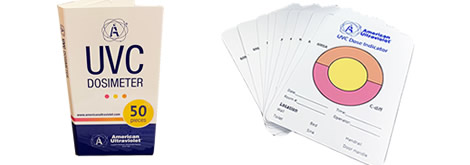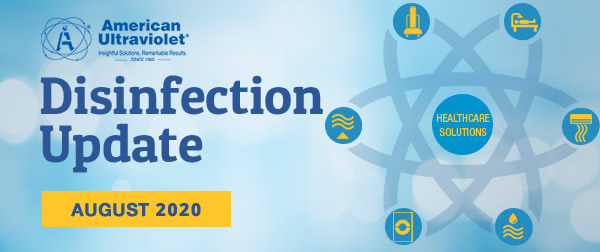
Just like Lego building blocks – The Four (4) Pillars of UVC disinfection
The following is an excerpt from Health Europa August 2020
American Ultraviolet uses the most comprehensive approach to UVC disinfection to safely cover all areas in a building, and we do so with a special focus on reducing microorganisms in the environment. This is the core concept behind the Four (4) pillars of UVC Disinfection. Since it is known that UVC reduces microorganisms in air, and on surfaces, a multi-prong approach can be used inside a building – treating air coming through the HVAC system; in-room air with continuous upper air disinfection; treating air and surfaces at the same time with mobile UVC solutions; and direct surface-mounted systems. The four (4) Pillars of UVC Disinfection are a logical step for any indoor environment, because the environment can be outfitted over time with solutions that provide100% UVC protection and, just like with Lego building blocks, the solutions can be customized to fit the specific environment and applications.
Four (4) Pillars of UVC Disinfection for Healthcare – A Closer Look
As part of American Ultraviolet's effort to provide you with a complete disinfection solution, and help you facilitate the implementation of an effective and efficient UVC disinfection program, the American Ultraviolet Four (4) Pillars of UVC Disinfection for Healthcare looks at the entire facility, and the main routes of transmission for microorganisms. The "Four (4) Pillars of UVC Disinfection for Healthcare" provide layers of protection to safeguard building occupants and staff.
Healthcare facilities, and highly populated spaces, unfortunately, can quickly become a breeding ground for microorganisms, hence infections. Because Environmental Services is often overwhelmed with daily tasks and is trying to keep up with proper touch point cleaning, in order to reduce the risk, they often miss the 100% clean mark. Time is money in the healthcare settings, where it is also mandatory to clean, or terminal clean, a patient room as quickly as possible, resulting in many areas missed and not properly disinfected. The same is true in all other environments where cleaning staff is often overwhelmed and simply cannot clean all surfaces to prevent transfer from surfaces to hands. Sick people, and their caregivers, including many with suppressed immune systems, are often grouped together in close quarters, and office workers share break rooms, restrooms, and meeting rooms, making them highly susceptible to microorganisms in the environment. Healthcare facilities worldwide must therefore be cognizant of these "flashpoints of infection," which include: Common areas where people gather and then disperse; areas used repeatedly by patients; equipment used to treat/transport/house patients; air circulating, and re-circulating, throughout facilities that are shared by patients, staff, and other occupants. Each flashpoint needs specific attention designed to help reduce the risk of infection. American Ultraviolet developed the necessary UVC disinfection solutions for each flashpoint with its unique approach - the "Four Pillars of UVC Disinfection for Healthcare" program. Concern over healthcare-associated infections is now being replaced with the fears of COVID-19 overwhelming the healthcare industry on a global scale. To help reduce the costs, healthcare facilities worldwide are using ultraviolet disinfection at all "flashpoints of infection" as a preventative action by implementing the four pillars in combination, or in phases. Depending on budget, and highest risk, the 4 pillars of disinfection are often integrated in various orders. Let us take a closer look at the 4 pillars.
Pillar One – Upper Air Disinfection
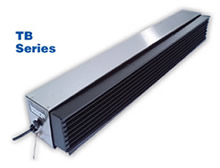 American Ultraviolet's Pillar One of the "Four Pillars of UVC Disinfection for Healthcare" is the Upper Air disinfection unit. These units provide a UVC blanket of protection over waiting rooms, conference rooms, exam rooms, patient in-take areas, common areas, and other "flashpoints." This style of fixture is designed to be safely used while occupants are in rooms, or in areas of congregation. The installation is at a minimum height of 7 ½ feet off of the floor, and the UVC lamps are shielded to direct the UVC energy upward and outward, creating a high intensity UVC zone in the upper portion of the room, while minimizing UVC levels in occupied spaces. These fixtures are designed to inactivate airborne microorganisms as air currents move them into the path of the UVC energy.
American Ultraviolet's Pillar One of the "Four Pillars of UVC Disinfection for Healthcare" is the Upper Air disinfection unit. These units provide a UVC blanket of protection over waiting rooms, conference rooms, exam rooms, patient in-take areas, common areas, and other "flashpoints." This style of fixture is designed to be safely used while occupants are in rooms, or in areas of congregation. The installation is at a minimum height of 7 ½ feet off of the floor, and the UVC lamps are shielded to direct the UVC energy upward and outward, creating a high intensity UVC zone in the upper portion of the room, while minimizing UVC levels in occupied spaces. These fixtures are designed to inactivate airborne microorganisms as air currents move them into the path of the UVC energy.
History has taught us that common areas where people gather and disperse, whether inside or outside a facility, have proven to be areas where disease can quickly transmit. The 1918 influenza pandemic, which was caused by an H1N1 virus with genes of avian origin, was the most severe pandemic in recent history.
An estimated 500 million people (one third of the world's population at the time) became infected with this virus, and the number of deaths was estimated to be at least 50 million worldwide. The high mortality rate in healthy people was a unique feature of this pandemic. Control efforts at the time were limited to isolation, quarantine, good personal hygiene, use of disinfectants, and limited public gatherings. No vaccine was available for this virus, and we are facing the same challenges today with COVID-19. However, since the introduction and availability of UVC equipment, environments can now be quickly and safely disinfected, and continuously kept at a much-reduced microorganism load.
In addition to new challenges, such as COVID-19, Tuberculosis (TB) remains a severe, contagious disease that primarily affects the lungs. It is usually transmitted from person to person via airborne particles that contain the TB bacteria. One of the major concerns for healthcare workers is the potential for transmission of TB, and many other airborne pathogens, at worksites, from undiagnosed or unsuspected cases. Upper-room ultraviolet germicidal irradiation (UVGI) systems are considered a supplement, or adjunct, to other control measures (e.g. ventilation), in settings where persons with undiagnosed could potentially contaminate the air (e.g. waiting rooms, conference rooms, exam rooms, patient in-take areas, common areas, and all flashpoints of disinfection).
Pillar Two – Mobile Room UVC Robots for Surface Disinfection
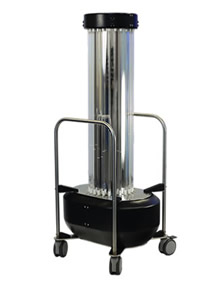 The Centers for Disease Control (CDC) estimates that hospital acquired infections (HAIs) account for 1.7 million infections, annually, in American hospitals alone (patientcarelink.org). Hospital patient rooms, recovery rooms, operating rooms, triage rooms, and any other locations in a healthcare facility that are used repeatedly to house infected hosts, are known to be "flashpoints of infections" from person to person. Patients in healthcare setting are at increased risk of exposure to organisms that are transmitted between patients and healthcare workers. And surfaces in areas touched by infected hosts can leave residue waiting to transfer and incubate, in new hosts. This process will continue for unsuspecting patients and healthcare staff.
The Centers for Disease Control (CDC) estimates that hospital acquired infections (HAIs) account for 1.7 million infections, annually, in American hospitals alone (patientcarelink.org). Hospital patient rooms, recovery rooms, operating rooms, triage rooms, and any other locations in a healthcare facility that are used repeatedly to house infected hosts, are known to be "flashpoints of infections" from person to person. Patients in healthcare setting are at increased risk of exposure to organisms that are transmitted between patients and healthcare workers. And surfaces in areas touched by infected hosts can leave residue waiting to transfer and incubate, in new hosts. This process will continue for unsuspecting patients and healthcare staff.
American Ultraviolet Pillar Two of the "Four Pillars of UVC Disinfection for Healthcare" are the mobile room disinfection robots. American Ultraviolet has designed these robots with the goal of targeting zero microorganisms in the environment around the patient. Sam Guzman, American Ultraviolet's Global Healthcare Sales Director, states that "Having the most comprehensive made in the USA product offering for mobile UVC "robots" has been a great advantage for our customers, because they can choose exactly the right size mobile unit for their respective environment. Our mobile UVC fleet covers all sizes of environments, and the high-performance, user-friendly, rugged, and non-intimidating designs have made them true customer favorites...plus they are affordable!" No matter the UVC mobile device size, they all have several important features in common: Medical grade certified high performance UVC lamps, coupled with on-board pre-programmed pathogen inactivation cycles, remote control and 360-degree safety features. There are four mobile solutions to choose from: the Mobile Room Solution (MRS) series, which consists of the MRS14, MRS33, and MRS45; and the state-of-the-art ARTZ 2.0 (Automatically Reliably Targeting Zero).
The ARTZ 2.0 has been rapidly growing into a new customer favorite for applications where inactivation speed is critical. Equipped with 24 medical grade UVC lamps that are designed to run continuously at maximum intensity allows for a very quick disinfection turn-around, even in larger spaces. Time savings = cost savings. ARTZ's sophisticated and intuitive controls package features data logging, is able to monitor productivity, and, because of internal diagnostics, is very user-friendly, and can be easily controlled and operated by any Wi-Fi enabled device. A hard case covering that protects the lamps during transport can also be used as a quick set-up if a barrier to a room or location is needed.
Allowing the mobile UVC robots to perform their disinfection job of inactivating the desired microorganisms, and validation methods, have been critical components when it comes to establishing device efficacy. American Ultraviolet empowers clients with the use of Dosimeter indicator cards to validate that sufficient UVC dosage was delivered.
All environments are unique, and many have various reflective surfaces, however, absorbing surfaces need to also be considered during device operation. What this means is that without a radiometer, or Dosimeter card, placed at or near critical surfaces (e.g. high touch points) during commissioning of a device, it will be "unknown" if the target dose was delivered. This validation step should be performed for all UVC mobile robots no matter what detection methods the device manufacture claims.
A current market demand is to have a fully autonomous version of mobile UVC disinfection devices. As the industry leader, American Ultraviolet has the opportunity to work with some of the most advanced robotic and automation companies on the planet to develop new solutions. The latest innovative result is "Techi UVC," a fully automated, autonomous disinfection robot. In a joint development with Techmetics Corporation, and Clear Focus LLC., American Ultraviolet has once again set the standard for the most innovative UVC equipment on the global market by introducing the Techi UVC autonomous robot. Techi UVC has the longest battery life available, offers multiple cycle settings, and is designed to minimize the need for human interaction. As with all products manufactured by American Ultraviolet, safety and performance were paramount during the design phase.
Product Spotlight: Pillar Three – Heating, Ventilation, Air-conditioning (HVAC)
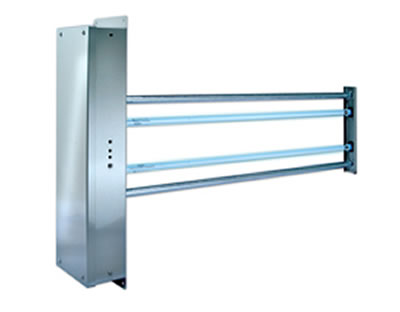 Unfiltered, contaminated air circulating, and re-circulating, through a healthcare facility can be another prime "flashpoint of infection." Though HVAC systems include all the equipment used to ventilate, heat/cool, and humidify/dehumidify, most do not address the disinfection of the air in a facility. Improper operation and maintenance of an HVAC system is one of the most common problems that impact the indoor air quality (IAQ) of a workplace.
Unfiltered, contaminated air circulating, and re-circulating, through a healthcare facility can be another prime "flashpoint of infection." Though HVAC systems include all the equipment used to ventilate, heat/cool, and humidify/dehumidify, most do not address the disinfection of the air in a facility. Improper operation and maintenance of an HVAC system is one of the most common problems that impact the indoor air quality (IAQ) of a workplace.
The third American Ultraviolet pillar, from the "Four Pillars of UVC Disinfection for Healthcare," consists of equipment that disinfect critical air streams circulating, and re-circulating, throughout healthcare facilities.
Infectious airborne microbiological agents, too small to be captured by filtration, can be disinfected as they pass through the "blanket of UVC energy." Custom sized in-duct UVC systems are one of American Ultraviolet's most popular applications. American Ultraviolet developed dedicated sizing software that allows for the selection of the appropriate UVC dosage levels for air and surface disinfection in-duct, and on the cooling coil. Surface disinfection of an HVAC system is used to help reduce any microbial growth on the internal surfaces of the HVAC system, which includes cooling coils, plenum walls, and drain pans. Air disinfection, also called "on-the-fly" inactivation of microbes suspended in air as they move through the ducting, is currently what most clients are looking for. Good filtration generally removes the larger microbes, like fungal spores, which are more resistant to UVC, while susceptible organisms such as bacteria and viruses are inactivated more quickly.
Following are the most popular American Ultraviolet HVAC solutions:
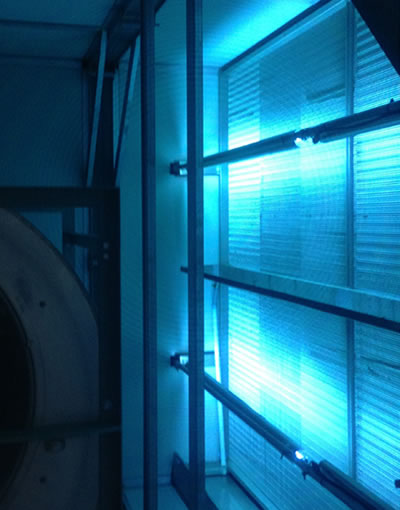 CK Series:
CK Series:
The CK Series is a customer favorite. This series is designed as a modular, highly flexible UVC kit for Air Handling Unit (AHU) installations. The kit is simple to install and can be configured to provide exactly what is needed for a wide variety of AHU installations. The CK Series is flexible enough to get everything needed for almost any UVC application. Standard configurations offer up to 16 lamps, with lamp lengths up to 60" running from a single electronic enclosure. The CK Series can be supplied with standard, coated, or double-walled cell lamps, based on requirements of the installation. The BMS option allows for lamp monitoring with relay output to a building's central monitoring system to ensure performance.
Learn more about the CK Series
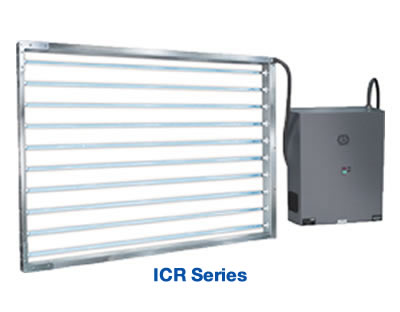 ICR Series:
ICR Series:
High-output ICR Series fixtures from American Ultraviolet are designed specifically for HVAC airstream disinfection applications. They are ideal for large air handling systems in commercial, industrial, healthcare, and institutional buildings. These ready-to-install framed structures can be easily mounted in-duct and on-coils to provide the desired airstream disinfection to deactivate unwanted bacteria, viruses or fungi travelling through the airstream. ICR Series fixtures not only decontaminate air, but they also use UVC energy to help remove biofilms from cooling coils and drain pans. The ICR Series can be mounted within minutes to plenum walls, or to frame assemblies that span supply ducts and/or cooling coils. These fixtures are offered in various lamp configurations and come standard in five different widths (18", 24", 36", 48", & 60"). Frames can be mounted side-by-side or stacked vertically to cover the entire plenum or coil.
Learn more about the ICR Series
 DC Series:
DC Series:
American Ultraviolet High-output DC Series HVAC UVC germicidal fixtures can be mounted in various configurations for optimum pass-by air decontamination, and/or to irradiate cooling coils and drain pans. Lamps and electronics can be accessed from outside the duct or plenum. "Green" lamps (contain 28mg of mercury) extend inside to span supply ducts and/or cooling coils.
DC Series HVAC air duct system fixtures are offered in two and four-lamp configurations that can be mounted singly, in built-up banks, or in parallel configurations in a variety of locations, including coils, drain pans, ductwork, mixed air plenums and exhaust systems.
Learn more about the DC Series
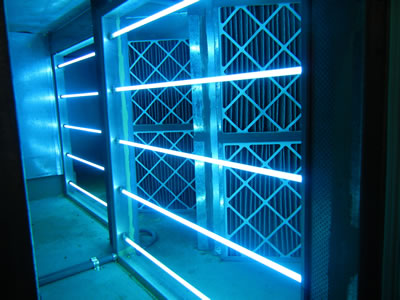 ECO Series:
ECO Series:
The Eco Pure series from American Ultraviolet is designed as an economical choice for on-coil use in commercial and residential HVAC systems. Because of a large range of lamp lengths, from 16" to 60", ease of installation, and an attractive, cost-effective price point, the ECO Series has quickly become a "go to" choice for many of our customers who use them in a wide range of installations..
Learn more about the ECO Series
Pillar Four – Fixed Mount Systems / UVC Fixed Mount package
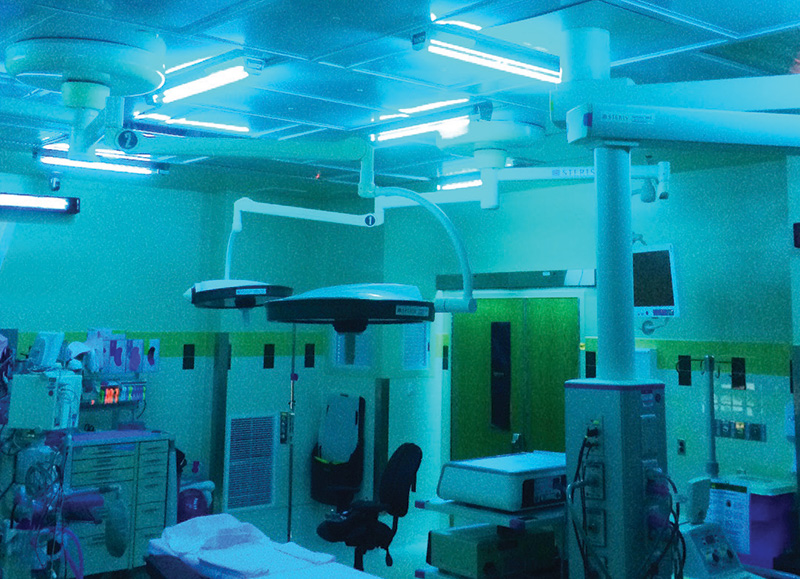 The fourth American Ultraviolet pillar, of the "Four Pillars of UVC Disinfection for Healthcare, is the "Fixed Mounted Packages". The most popular fixed mount package is the UVC OR package for operating theaters. These systems are designed to combat easily preventable complications during surgeries. Surgical site infection (SSI) - defined by the Centers for Disease Control and Prevention (CDC) as "an infection related to an operative procedure that occurs at or near the surgical incision within 30 days of the procedure, or within 90 days if prosthetic material is implanted at surgery," is among the most common preventable complication after surgery. SSIs occur in 2% to 4% of all patients undergoing inpatient surgical procedures. They are also the leading cause of readmissions to the hospital following surgery. Approximately 3% of patients who contract an SSI will die consequently (ahrq.gov).
The fourth American Ultraviolet pillar, of the "Four Pillars of UVC Disinfection for Healthcare, is the "Fixed Mounted Packages". The most popular fixed mount package is the UVC OR package for operating theaters. These systems are designed to combat easily preventable complications during surgeries. Surgical site infection (SSI) - defined by the Centers for Disease Control and Prevention (CDC) as "an infection related to an operative procedure that occurs at or near the surgical incision within 30 days of the procedure, or within 90 days if prosthetic material is implanted at surgery," is among the most common preventable complication after surgery. SSIs occur in 2% to 4% of all patients undergoing inpatient surgical procedures. They are also the leading cause of readmissions to the hospital following surgery. Approximately 3% of patients who contract an SSI will die consequently (ahrq.gov).
The fixed mounted packages consist of a variety of permanently mounted fixtures that can be retrofitted to an existing OR Suite or critical area. The systems are computer controlled and designed to be utilized for entire room disinfection before and after gatherings or meetings in highly populated spaces, in between surgeries, and even during surgeries for various orthopedic procedures.
The goal is to reduce pathogens on surfaces, and in the air, quickly and safely, without the need for additional staff.
While the primary product in this series is the UVC OR package, the system was designed to be modular, meaning the components can be configured to achieve your disinfection goals in any space. Labs, isolation rooms, exam rooms, and meeting rooms are all places where a hard-mounted system makes sense.
Visit the Disinfection Update E-newsletter archives (which begin with March 2020) to read helpful stories about the effectiveness of UVC Disinfection.
None of the American Ultraviolet UVC products detailed above are certified, or approved under any applicable laws, as a medical device, and as such, American Ultraviolet, and its Representatives and Distributors, do not currently intend for them to be used as medical devices anywhere globally. Products have not been evaluated by the FDA.
